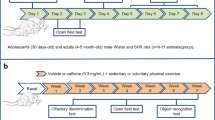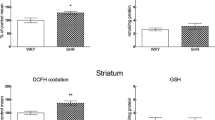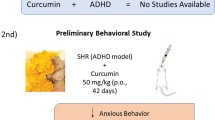Abstract
Epidemiological studies suggest sex differences in attention deficit and hyperactivity disorder (ADHD) symptomatology. The potential benefits of caffeine have been reported in the management of ADHD, but its effects were not properly addressed with respect to sex differences. The present study examined the effects of caffeine (0.3 g/L) administered since childhood in the behavior and brain-derived neurotrophic factor (BDNF) and its related proteins in both sexes of a rat model of ADHD (spontaneously hypertensive rats—SHR). Hyperlocomotion, recognition, and spatial memory disturbances were observed in adolescent SHR rats from both sexes. However, females showed lack of habituation and worsened spatial memory. Although caffeine was effective against recognition memory impairment in both sexes, spatial memory was recovered only in female SHR rats. Besides, female SHR rats showed exacerbated hyperlocomotion after caffeine treatment. SHR rats from both sexes presented increases in the BDNF, truncated and phospho-TrkB receptors and also phospho-CREB levels in the hippocampus. Caffeine normalized BDNF in males and truncated TrkB receptor at both sexes. These findings provide insight into the potential of caffeine against fully cognitive impairment displayed by females in the ADHD model. Besides, our data revealed that caffeine intake since childhood attenuated behavioral alterations in the ADHD model associated with changes in BDNF and TrkB receptors in the hippocampus.











Similar content being viewed by others
References
Thomas R, Sanders S, Doust J, Beller E, Glasziou P (2015) Prevalence of attention-deficit/hyperactivity disorder: a systematic review and meta-analysis. Pediatrics 135:e994–e100
American Psychiatric Association (1994) Diagnostic and statistical manual of mental disorders, 4th edn. American Psychiatric Association, Washington, DC
Biederman J, Faraone SV, Monuteaux MC, Bober M, Cadogen E (2004) Gender effects on attention-deficit/hyperactivity disorder in adults, revisited. Biol Psychiatry 55:692–700
Gershon J (2002) A meta-analytic review of gender differences in ADHD. J Atten Disord 5:143–154
Lenroot RK, Gogtay N, Greenstein DK, Wells EM, Wallace GL, Clasen LS, Blumenthal JD, Lerch J et al (2007) Sexual dimorphism of brain developmental trajectories during childhood and adolescence. NeuroImage 36:1065–1073
Andersen SL (2005) Stimulants and the developing brain. Trends Pharmacol Sci 26:237–243
Nussbaum NL (2012) ADHD and female specific concerns: a review of the literature and clinical implications. J Atten Disord 16:87–100
Shaw P, Gornick M, Lerch J, Addington A, Seal J, Greenstein D, Sharp W, Evans A et al (2007) Polymorphisms of the dopamine D4 receptor, clinical outcome, and cortical structure in attention-deficit/hyperactivity disorder. Arch Gen Psychiatry 64:921–931
Balaratnasingam S, Janca A (2012) Brain derived neurotrophic factor: a novel neurotrophin involved in psychiatric and neurological disorders. Pharmacol Therap 134:116–124
Bryn V, Halvorsen B, Ueland T, Isaksen J, Kolkova K, Ravn K, Skjeldal OH (2015) Brain derived neurotrophic factor (BDNF) and autism spectrum disorders (ASD) in childhood. Eur J Paediatr Neurol 19:411–414
Kent L, Green E, Hawi Z, Kirley A, Dudbridge F, Lowe N, Raybould R, Langley K et al (2005) Association of the paternally transmitted copy of common valine allele of the Val66Met polymorphism of the brain-derived neurotrophic factor (BDNF) gene with susceptibility to ADHD. Mol Psychiatry 10:939–943
Kim BN, Cummins TDR, Kim JW, Bellgrove MA, Hong SB, Song SH, Shin MS, Cho SC et al (2011) Val/Val genotype of brain-derived neurotrophic factor (BDNF) Val66Met polymorphism is associated with a better response to OROS-MPH in Korean ADHD children. Int J Neuropsychopharmacol 14:1399–1410
Lanktree M, Squassina A, Krinsky M, Strauss J, Jain U, Macciardi F, Kennedy JL, Muglia P (2008) Association study of brain-derived neurotrophic factor (BDNF) and LIN-7 homolog (LIN-7) genes with adult attention-deficit/hyperactivity disorder. Am J Med Genet Part B, Neuropsychiatr Genet Off Publ Int Soc Psychiatr Genet 147B:945–951
Tsai SJ (2016) Role of neurotrophic factors in attention deficit hyperactivity disorder. Cytokine Growth Factor Rev S1359-6101(16):30138–30131
Liu DY, Shen XM, Yuan FF, Guo OY, Zhong Y, Chen JG, Zhu LQ, Wu J (2015) The physiology of BDNF and its relationship with ADHD. Mol Neurobiol 52:1467–1476
Amiri A, Torabi Parizi G, Kousha M, Saadat F, Modabbernia MJ, Najafi K, Atrkar Roushan Z (2013) Changes in plasma brain-derived neurotrophic factor (BDNF) levels induced by methylphenidate in children with attention deficit–hyperactivity disorder (ADHD). Prog Neuro-Psychopharmacol Biol Psych 47:20–24
Bilgiç A, Toker A, Işık Ü, Kılınç İ (2017) Serum brain-derived neurotrophic factor, glial-derived neurotrophic factor, nerve growth factor, and neurotrophin-3 levels in children with attention-deficit/hyperactivity disorder. Eur Child Adolesc Psychiatry 26:355–363
Ramos-Quiroga JA, Corominas-Roso M, Palomar G, Gomez-Barros N, Ribases M, Sanchez-Mora C, Bosch R, Nogueira M et al (2014) Changes in the serum levels of brain-derived neurotrophic factor in adults with attention deficit hyperactivity disorder after treatment with atomoxetine. Psychopharmacology 231:1389–1395
Fredholm BB, Bättig K, Holmén J, Nehlig A, Zvartau EE (1999) Actions of caffeine in the brain with special reference to factors that contribute to its widespread use. Pharmacol Rev 51:83–133
Ioannidis K, Chamberlain SR, Müller U (2014) Ostracising caffeine from the pharmacological arsenal for attention-deficit hyperactivity disorder—was this a correct decision? A literature review. J Psychopharmacol 28:830–836
Garfinkel BD, Webster CD, Sloman L (1981) Responses to methylphenidate and varied doses of caffeine in children with attention deficit disorder. Can J Psychiatr 26:395–401
Harvey DHP, Marsh RW (1978) The effects of de-caffeinated coffee versus whole coffee on hyperactive children. Dev Med Child Neurol 20:81–86
Firestone P, Davey J, Goodman JT, Peters S (1978) The effects of caffeine and methylphenidate on hyperactive children. J Am Acad Child Psychiatry 17:445–456
Leon MR (2000) Effects of caffeine on cognitive, psychomotor, and affective performance of children with attention-deficit/hyperactivity disorder. J Atten Disord 4:27–47
Del-Ponte B, Santos IS, Tovo-Rodrigues L, Anselmi L, Munhoz TN, Matijasevich A (2016) Caffeine consumption during pregnancy and ADHD at the age of 11 years: a birth cohort study. BMJ Open 6:e012749
Takahashi RN, Pamplona FA, Prediger RD (2008) Adenosine receptor antagonists for cognitive dysfunction: a review of animal studies. Front Biosci 13:2614–2632
Russell VA (2011) Overview of animal models of attention deficit hyperactivity disorder (ADHD). Curr Protoc Neurosci 9:9.35
Sagvolden T, Russell VA, Aase H, Johansen EB, Farshbaf M (2005) Rodent models of attention-deficit/hyperactivity disorder. Biol Psychiatry 57:1239–1247
Pandolfo P, Machado NJ, Köfalvi A, Takahashi RN, Cunha RA (2013) Caffeine regulates frontocorticostriatal dopamine transporter density and improves attention and cognitive deficits in an animal model of attention deficit hyperactivity disorder. Eur Neuropsychopharmacol 23:317–328
Pires VA, Pamplona FAF, Pandolfo P, Fernandes D, Prediger RD, Takahashi RN (2009) Adenosine receptor antagonists improve short-term object-recognition ability of spontaneously hypertensive rats: a rodent model of attention-deficit hyperactivity disorder. Behav Pharmacol 20:134–145
Pires VA, Pamplona FA, Pandolfo P, Prediger RDS, Takahashi RN (2010) Chronic caffeine treatment during prepubertal period confers long-term cognitive benefits in adult spontaneously hypertensive rats (SHR), an animal model of attention deficit hyperactivity disorder (ADHD). Behav Brain Res 215:39–44
Prediger RDS, Pamplona FA, Fernandes D, Takahashi RN (2005) Caffeine improves spatial learning deficits in an animal model of attention deficit hyperactivity disorder (ADHD)—the spontaneously hypertensive rat (SHR). Int J Neuropsychopharmacol 8:583–594
Bayless DW, Perez MC, Daniel JM (2015) Comparison of the validity of the use of the spontaneously hypertensive rat as a model of attention deficit hyperactivity disorder in males and females. Behav Brain Res 286:85–92
Botanas CJ, Lee H, de la Peña JB, dela Peña IJ, Woo T, Kim HJ, Han DH, Kim BN et al (2016) Rearing in an enriched environment attenuated hyperactivity and inattention in the spontaneously hypertensive rats, an animal model of attention-deficit hyperactivity disorder. Physiol Behav 155:30–37
Langen B, Dost R (2011) Comparison of SHR, WKY and Wistar rats in different behavioural animal models: effect of dopamine D1 and alpha2 agonists. Atten Def Hyp Disord 3:1–12
Yang MT, Lu DH, Chen JC, Fu WM (2015) Inhibition of hyperactivity and impulsivity by carbonic anhydrase inhibitors in spontaneously hypertensive rats, an animal model of ADHD. Psychopharmacology 232:3763–3772
Bucci DJ, Hopkins ME, Keene CS, Sharma M, Orr LE (2008) Sex differences in learning and inhibition in spontaneously hypertensive rats. Behav Brain Res 187:27–32
Bucci DJ, Hopkins ME, Nunez AA, Breedlove SM, Sisk CL, Nigg JT (2008) Effects of sex hormones on associative learning in spontaneously hypertensive rats. Physiol Behav 93:651–657
Berger DF, Sagvolden T (1998) Sex differences in operant discrimination behaviour in an animal model of attention-deficit hyperactivity disorder. Behav Brain Res 94:73–82
Sagvolden T, Berger DF (1996) An animal model of attention deficit disorder: the female shows more behavioral problems and is more impulsive than the male. Eur Psychol 1:113–122
Clements KM, Girard TA, Xing HC, Wainwright PE (2003) Spontaneously hypertensive and Wistar Kyoto rats differ in delayed matching-to-place performance and response to dietary long-chain polyunsaturated fatty acids. Dev Psychobiol 43:57–69
Kim J, Park H, Yu SL, Jee S, Cheon KA, Song DH, Kim SJ, Im WY et al (2016) Effects of high-frequency repetitive transcranial magnetic stimulation (rTMS) on spontaneously hypertensive rats, an animal model of attention-deficit/hyperactivity disorder. Int J Dev Neurosci 53:83–89
Mook DM, Jeffrey J, Neuringer A (1993) Spontaneously hypertensive rats (SHR) readily learn to vary but not repeat instrumental responses. Behav Neural Biol 59:126–135
Sontag TA, Fuermaier AB, Hauser J, Kaunzinger I, Tucha O, Lange KW (2013) Spatial memory in spontaneously hypertensive rats (SHR). PLoS One 8:e74660
Wyss JM, Chambless BD, Kadish I, van Groen T (2000) Age-related decline in water maze learning and memory in rats: strain differences. Neurobiol Aging 21:671–681
Jeong HI, Ji ES, Kim SH, Kim TW, Baek SB, Choi SW (2014) Treadmill exercise improves spatial learning ability by enhancing brain-derived neurotrophic factor expression in the attention-deficit/hyperactivity disorder rats. J Exerc Rehabil 10:162–167
Shim SH, Hwangbo Y, Kwon YJ, Jeong HY, Lee BH, Lee HJ, Kim YK (2008) Increased levels of plasma brain-derived neurotrophic factor (BDNF) in children with attention deficit-hyperactivity disorder (ADHD). Prog Neuropsychopharmacol Biol Psych 32:1824–1828
Corominas-Roso M, Ramos-Quiroga JA, Ribases M, Sanchez-Mora C, Palomar G, Valero S, Bosch R, Casas M (2013) Decreased serum levels of brain-derived neurotrophic factor in adults with attention-deficit hyperactivity disorder. Int J Neuropsychopharmacol 16:1267–1275
Bergman O, Westberg L, Lichtenstein P, Eriksson E, Larsson H (2011) Study on the possible association of brain-derived neurotrophic factor polymorphism with the developmental course of symptoms of attention deficit and hyperactivity. Int J Neuropsychopharmacol 14:1367–1376
Sanchez-Mora C et al (2010) Meta-analysis of brain-derived neurotrophic factor p.Val66Met in adult ADHD in four European populations. Am J Med Genet B Neuropsychiatr Genet 153B:512–523
Callaghan CK, Kelly ÁM (2012) Differential BDNF signaling in dentate gyrus and perirhinal cortex during consolidation of recognition memory in the rat. Hippocampus 22:2127–2135
Skaper SD (2008) The biology of neurotrophins, signalling pathways, and functional peptide mimetics of neurotrophins and their receptors. CNS Neurol Dis - Drug Targets 7:46–62
Yang J, Siao CJ, Nagappan G, Marinic T, Jing D, McGrath K, Chen ZY, Mark W et al (2009) Neuronal release of proBDNF. Nat Neurosci 12:113–115
Danzer SC, Crooks KR, Lo DC, McNamara JO (2002) Increased expression of brain-derived neurotrophic factor induces formation of basal dendrites and axonal branching in dentate granule cells in hippocampal explant cultures. J Neurosci 22:9754–9763
Connolly S, Kingsbury TJ (2010) Caffeine modulates CREB-dependent gene expression in developing cortical neurons. Biochem Biophys Res Commun 397:152–156
Danelon V, Montroull LE, Unsain N, Barker PA, Mascó DH (2016) Calpain-dependent truncated form of TrkB-FL increases in neurodegenerative processes. Mol Cell Neurosci 75:81–92
Gomes JR, Costa JT, Melo CV, Felizzi F, Monteiro P, Pinto MJ, Inacio AR, Wieloch T et al (2012) Excitotoxicity downregulates TrkB.FL signaling and upregulates the neuroprotective truncated TrkB receptors in cultured hippocampal and striatal neurons. J Neurosci 32:4610–4622
Gupta VK, You Y, Gupta VB, Klistorner A, Graham SL (2013) TrkB receptor signalling: implications in neurodegenerative, psychiatric and proliferative disorders. Int J Mol Sci 14:10122–10142
D'Andrea I, Fardella V, Fardella S, Pallante F, Ghigo A, Iacobucci R, Maffei A, Hirsch E et al (2015) Lack of kinase-independent activity of PI3Kγ in locus coeruleus induces ADHD symptoms through increased CREB signaling. EMBO Mol Med 7:904–917
Banerjee PS, Aston J, Khundakar AA (2009) Differential regulation of psychostimulant-induced gene expression of brain derived neurotrophic factor and the immediate-early gene arc in the juvenile and adult brain. Eur J Neurosci 29:465–476
Fumagalli F, Cattaneo A, Caffino L, Ibba M, Racagni G, Carboni E, Gennarelli M, Riva MA (2010) Sub-chronic exposure to atomoxetine up-regulates BDNF expression and signalling in the brain of adolescent spontaneously hypertensive rats: comparison with methylphenidate. Pharmacol Res 62:523–529
Meredith G, Callen S, Scheuer D (2002) Brain-derived neurotrophic factor expression is increased in the rat amygdala, piriform cortex and hypothalamus following repeated amphetamine administration. Brain Res 949:218–227
Bolaños CA, Barrot M, Berton O, Wallace-Black D, Nestler EJ (2003) Methylphenidate treatment during pre- and periadolescence alters behavioral responses to emotional stimuli at adulthood. Biol Psychiatry 54:1317–1329
Dow-Edwards DL, Busidan Y (2001) Behavioral responses to dopamine agonists in adult rats exposed to cocaine during the preweaning period. Pharmacol Biochem Behav 70:23–30
Arendash GW, Mori T, Cao C, Mamcarz M, Runfeldt M, Dickson A, Rezai-Zadeh K, Tan J et al (2009) Caffeine reverses cognitive impairment and decreases brain amyloid-beta levels in aged Alzheimer’s disease mice. J Alzheimers Dis 17:661–680
Botton PH et al (2017) Aged mice receiving caffeine since adulthood show distinct patterns of anxiety-related behavior. Physiol Behav 170:47–53
Cao C, Loewenstein DA, Lin X, Zhang C, Wang L, Duara R, Wu Y, Giannini A et al (2012) High blood caffeine levels in MCI linked to lack of progression to dementia. J Alzheimers Dis 30:559–572
Costa MS, Botton PH, Mioranzza S, Souza DO, Porciúncula LO (2008) Caffeine prevents age-associated recognition memory decline and changes brain-derived neurotrophic factor and tirosine kinase receptor (TrkB) content in mice. Neuroscience 153:1071–1078
Ritchie K, Carriere I, de Mendonca A, Portet F, Dartigues JF, Rouaud O, Barberger-Gateau P, Ancelin ML (2007) The neuroprotective effects of caffeine: a prospective population study (the Three City Study). Neurology 69:536–545
Ardais AP, Borges MF, Rocha AS, Sallaberry C, Cunha RA, Porciúncula LO (2014) Caffeine triggers behavioral and neurochemical alterations in adolescent rats. Neuroscience 270:27–39
Ardais AP, Rocha AS, Borges MF, Fioreze GT, Sallaberry C, Mioranzza S, Nunes F, Pagnussat N et al (2016) Caffeine exposure during rat brain development causes memory impairment in a sex selective manner that is offset by caffeine consumption throughout life. Behav Brain Res 303:76–84
Mioranzza S, Nunes F, Marques DM, Fioreze GT, Rocha AS, Botton PHS, Costa MS, Porciúncula LO (2014) Prenatal caffeine intake differently affects synaptic proteins during fetal brain development. Int J Dev Neurosci 36:45–52
Silva CG, Metin C, Fazeli W, Machado NJ, Darmopil S, Launay PS, Ghestem A, Nesa MP et al (2013) Adenosine receptor antagonists including caffeine alter fetal brain development in mice. Sci Transl Med 5:197ra104
Sallaberry C, Ardais AP, Rocha A, Borges MF, Fioreze GT, Mioranzza S, Nunes F, Pagnussat N et al (2018) Sex differences in the effects of pre- and postnatal caffeine exposure on behavior and synaptic proteins in pubescent rats. Prog Neuro-Psychopharmacol Biol Psychiatry 81:416–425
Biederman J, Mick E, Faraone SV, Braaten E, Doyle A, Spencer T (2002) Influence of gender on attention déficit hyperactivity disorder in children referred to a psychiatric clinic. Am J Psych 159:36–42
Brackney RJ, Cheung TH, Herbst K, Hill JC, Sanabria F (2012) Extinction learning deficit in a rodent model of attention-deficit hyperactivity disorder. Behav Brain Funct 8:59
Wender PH (1998) Pharmacotherapy of attention deficit/hyperactivity disorder in adults. J Clin Psychiatry 59:76–79
Wilens TE, Spencer TJ, Biederman J (2002) A review of the pharmacotherapy of adults with attention deficit/hyperactivity disorder. J Atten Disord 5:189–202
Acknowledgements
The authors acknowledge Brazilian funding agencies (CAPES, CNPq, FAPERGS).
Author information
Authors and Affiliations
Contributions
F.N., D.P., A.S.A, and D.M.M. performed the experiments and revised the manuscript. F.N and L.O.P designed the study, analyzed and interpreted data, and wrote the manuscript.
Corresponding author
Ethics declarations
Conflict of Interest
The authors declare that they have no conflict of interest.
Rights and permissions
About this article
Cite this article
Nunes, F., Pochmann, D., Almeida, A.S. et al. Differential Behavioral and Biochemical Responses to Caffeine in Male and Female Rats from a Validated Model of Attention Deficit and Hyperactivity Disorder. Mol Neurobiol 55, 8486–8498 (2018). https://doi.org/10.1007/s12035-018-1000-5
Received:
Accepted:
Published:
Issue Date:
DOI: https://doi.org/10.1007/s12035-018-1000-5




